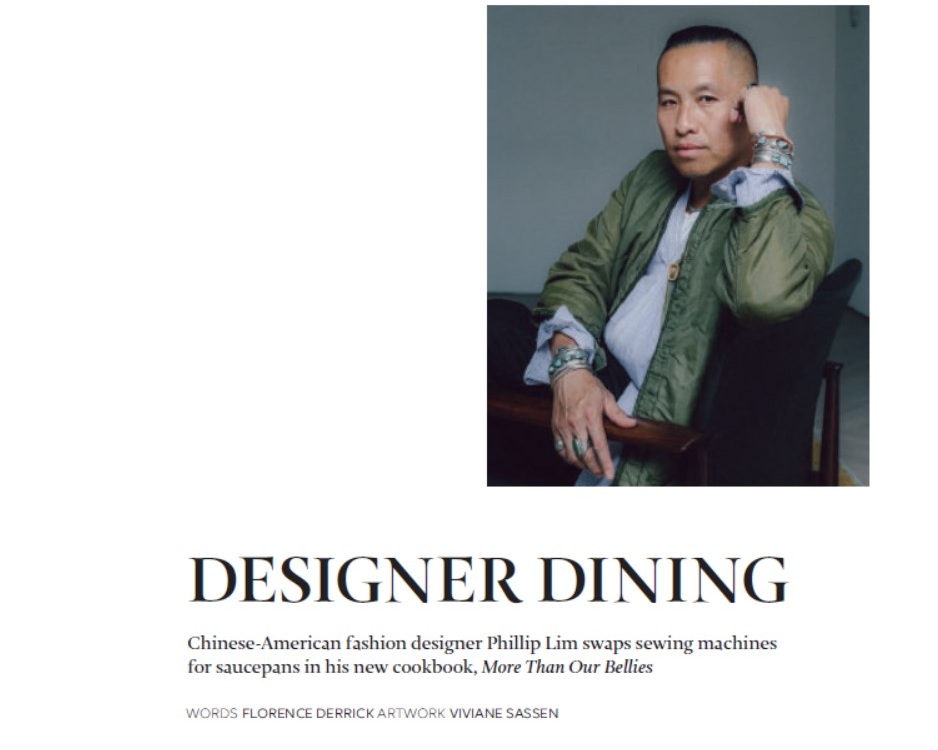THE TANGY-SWEET SCENT of chilli pepper, ginger, garlic and oyster sauce spiked with a splash of pungent fish sauce wafts from the wok. I stir through pieces of chicken, which sizzle stickily, the sauce caramelising into a thick, spicy-sweet coating. A handful of shredded basil later, it is ready. This is “Mom’s Ginger and Basil Chicken”, the signature dish from Chinese-American fashion designer Phillip Lim’s new cookbook, More Than Our Bellies, which he created in collaboration with Dutch artist and photographer Viviane Sassen to celebrate food, travel and family.
Lim co-founded fashion label 3.1 Phillip Lim in 2005 and is now one of the most successful independent designers in America. His structured, wearable designs have won him accolades from the Council of Fashion Designers of America – for womenswear in 2007 and for menswear in 2012 – and his Fall 2019 collection continues to build on the label’s signature structured yet casual aesthetic, with clean tailoring and muted palette. But this year also spells a new creative outlet for Lim, who recently discovered the pleasures of home cooking – a humbling antidote to high fashion.
The first-generation child of a Chinese couple, who moved to the United States in 1974 via Cambodia and Thailand, Lim grew up with a south-east Asian-influenced Chinese diet, cooked from scratch by his mother. But as a typical kid in the American school system, he rebelled. “I grew up in two worlds,” he says. “My parents wanted me to assimilate into Western culture, but the rules, food and language at home were all Chinese. When you’re a kid, you want McDonald’s and boxed cereal.” It wasn’t until Lim moved to New York City 14 years ago, to forge his fashion career, that he eventually reconnected with his ancestors’ food.
“For the first 10 years, I’d order takeout morning, noon and night,” says Lim. “I didn’t realise how bad it was for my body, but I was sluggish and feeling kind of hollow. Then, one day, I was missing my mother so much. She used to make me this basil ginger chicken which always put me in a good mood. I bought the ingredients I thought were in it, and went home and recreated it.”
That must have been no mean feat for a man who had never cooked before in his life – “My mum never taught me to cook,” he says, “she was old school that way” – but the chicken dish revealed to Lim that there’s more depth to food than its flavour.
“In South East Asia, they use humble ingredients that are actually antioxidants and superfoods,” says Lim. “Recently, I took a trip to Cambodia and in that humid climate there are a lot of mosquitoes. As a tourist, I was putting on loads of repellent and [I noticed] that the locals were not. It is because they eat food that naturally repels bugs, such as lemongrass. It is a traditional way of healing.”
Lim paid attention and, as a frequent traveller, uses his newfound food ethos to keep jet lag and fatigue at bay. “One of the major ingredients in Thai tom yum soup, for example, is galangal, which rebalances you,” he claims. “And kaffir lime de-puffs and helps remedy jet lag. Now, whenever I have been away and come home, I make that soup.”
Despite this, Lim insists that he is no chef – and it is clear that More Than Our Bellies is no ordinary cookbook. The accompanying photography by Lim’s friend and long-time collaborator Viviane Sassen does not correspond to the recipes. Instead, the artful shots, taken on her travels in Asia and Africa – Morocco, Ethiopia and Madagascar – display ripe, cut-open tomatoes on a market stand; sacks of rice glowing white under the sun; and trays of fried fish laid in silvery rows on a street-side stall. “We had travelled the world together and developed a mutual love and respect for non-Western cultures,” explains Lim. “This book is a love letter to each other.” It blurs the line between cookbook, travel documentary and fine-art tome – and for Lim it was a way to celebrate and connect to the people he loves.
“When I make clothes, I think of who wears them, how he or she might feel,” he says. “My goal is to make them feel at home, to give them armour to create memories in. And I do not know how it is going to turn out, which is the same with cooking. You are just trying to capture what was in your imagination.”
Born from an imagination as fruitful as Lim’s, it is no wonder that More Than Our Bellies has drawn the attention of the fashion, food and art worlds all at once. But the proof is always in the pudding. I place the ginger basil chicken atop a steaming bowl of white rice, grab a pair of chopsticks and dig in. It is tender, sweet and spicy; comfort on a plate. If Lim’s way of healing body and soul is this delicious, I think, then let him be my guru.
31philliplim.com, vivianesassen.com

